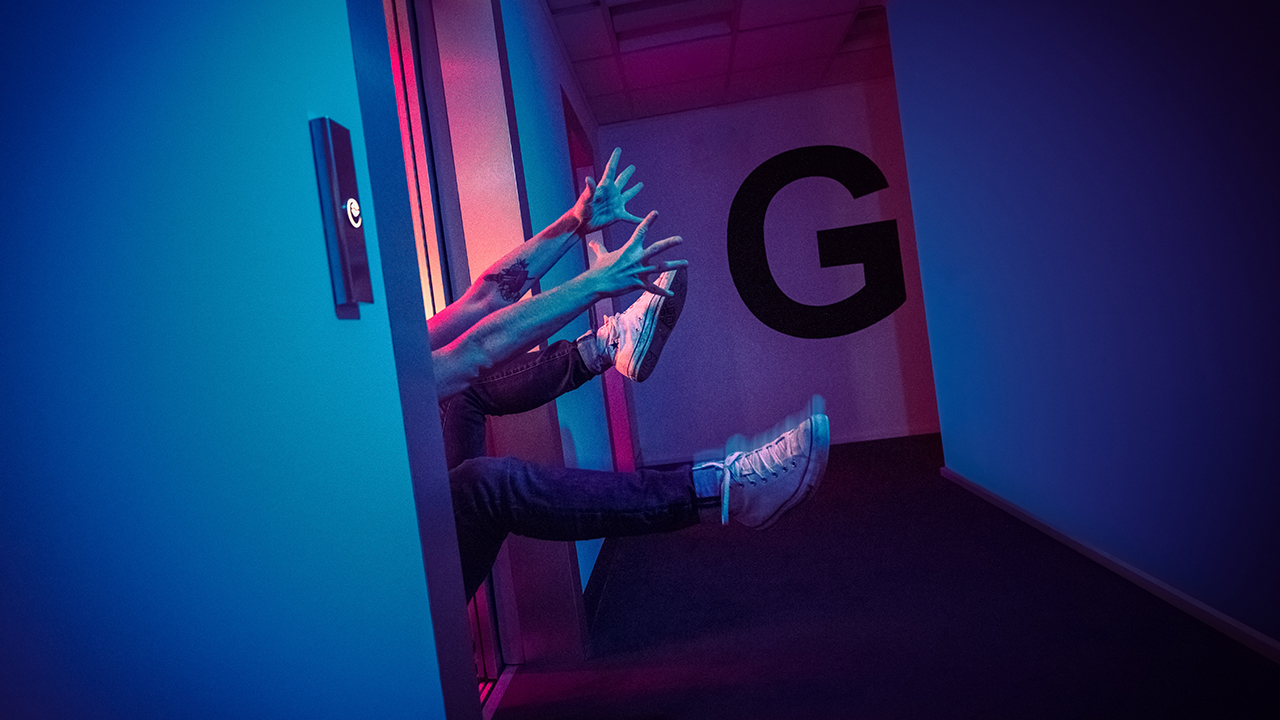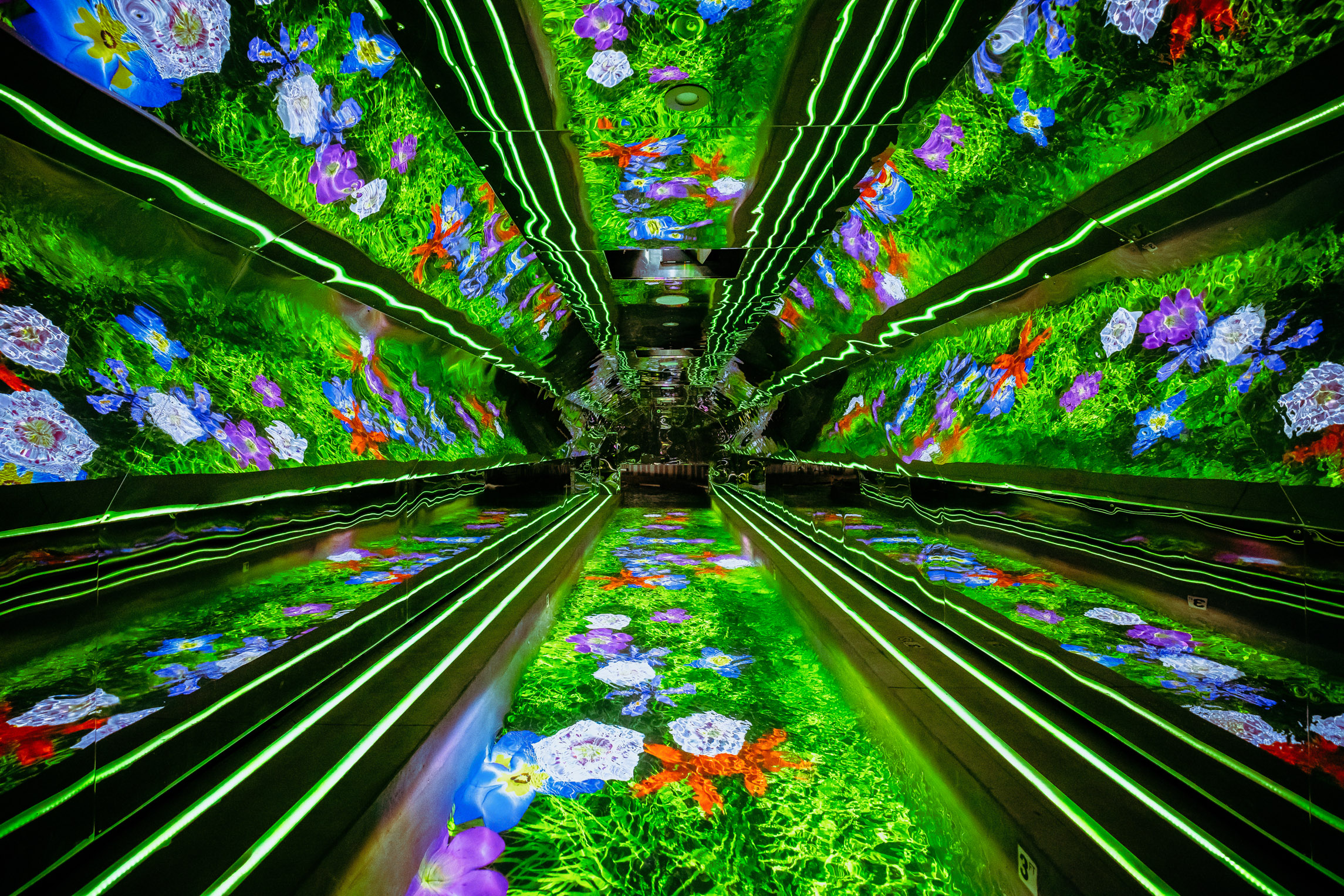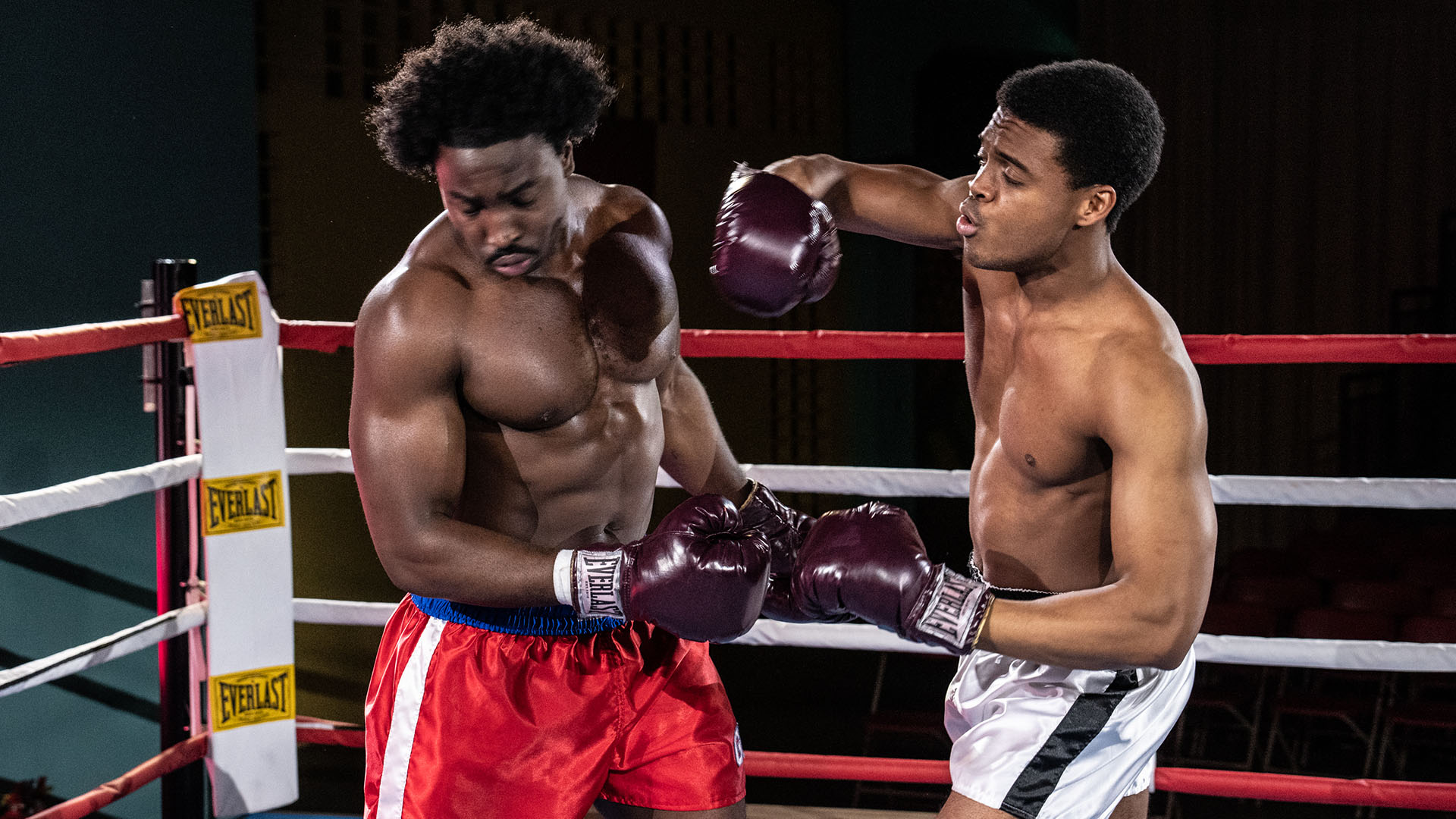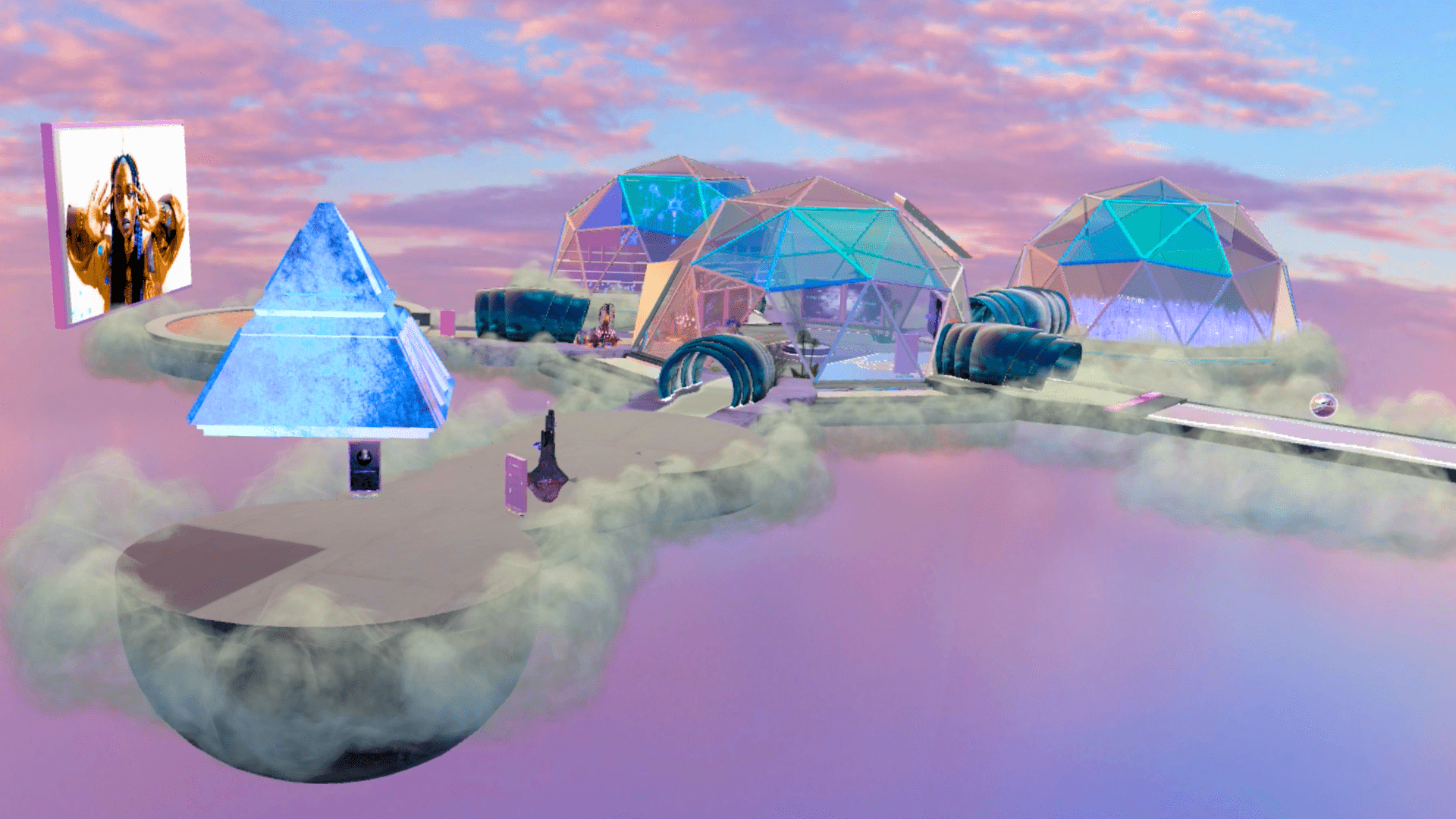Masked men. Secret codes. And a mysterious bejewelled book…
The WXO team recently dropped into London’s criminal underworld for the preview run of The Drop, the latest pulse-quickening experience from British immersive entertainment company Swamp Motel.
SPOILER ALERT: If there’s any chance you’re going to go to The Drop, STOP reading NOW. It’s a fantastic, scary, wild ride of an experience. There’s a lot to love and to learn from it. And you’ll get more if you JUST GO.
The Drop invites intimate teams of four to step into a lift and attempt to:
- Unearth the dark history of a long-lost book
- Interact with friends and foes
- Attempt to prevent a horrifying crime
- Solve puzzles and sabotage security systems
Comprising a team of Punchdrunk and Secret Cinema alumni, Swamp Motel previously thrilled us with their pandemic-proof digital experience The Kindling Hour (read our reviews here and here). WXO CEO James Wallman, WXO Editor Olivia Squire and creative director and WXO Founding Member Mark Slade give their thoughts on their latest immersive theatre-meets-escape room drama…
James Wallman: “Who was brave enough to go in first? We were all chattering, laughing, on edge…”
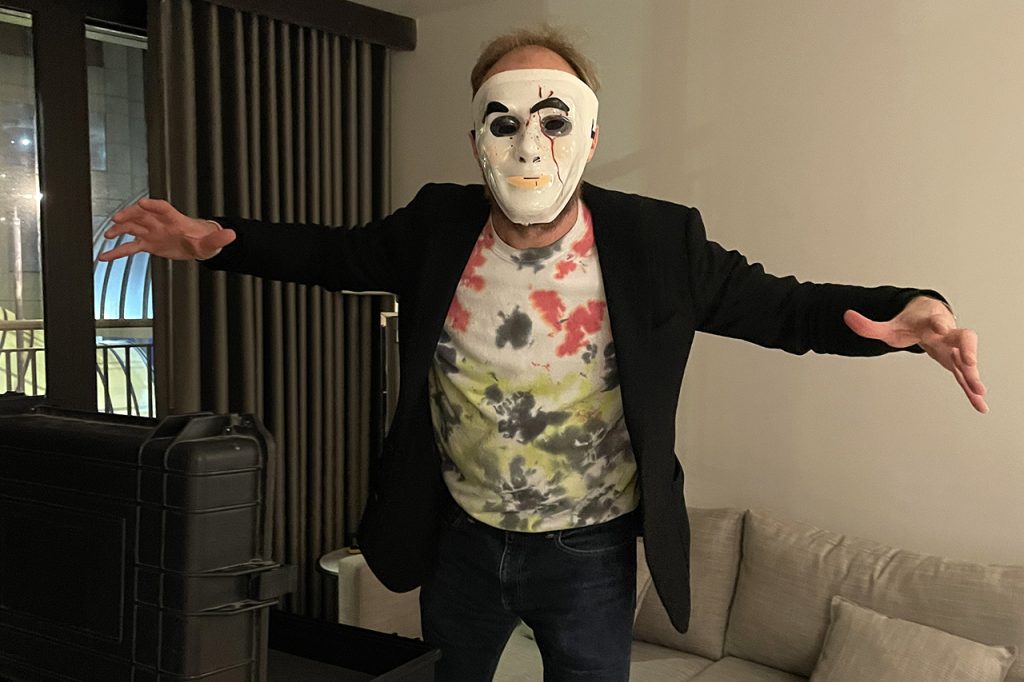
What’s good about the experience?
- Before anything, The Drop was a hell of a lot of fun. I was completely immersed. I completely forgot all the other things I was busy with. I had a really good time with the people I went with. And I came away with a surprising, standout memory.
- It was also really, really, oddly scary. I hadn’t expected to be actually scared. (Look at Campfire 22, where Aga Szostek explained how bursting expectation is so important for memorability. Consider Colin Shaw’s observation, made during Campfire 10, that when deciding what to do, people don’t compare experiences, they compare the memory of experiences.)
- The key way they made it feel so viscerally scary, I think, was the blurring of reality and the fantasy world of the escape game we were playing. This what’s real / what’s fake blurring happened early, and it happened late too.
- In a very surreal moment, not long after we’d entered the experience, it seemed like there was a problem in the lift we were in. Someone came on the intercom, apparently to check to see if things were working OK. So we were jolted out of the escape room set we were (locked) in – and then Something Happened out there. Before we were playing along with a story that had been laid out for us. We were willing participants in our own suspension of disbelief. But this layering was another level. It no longer mattered if we were willing or not. This sleight of hand flipped us into a state where we didn’t know what to believe.
- Then, later, it happened again. We’d clambered through a tunnel, we’d solved puzzles in rooms — a store room and a perfumer’s — that felt both real but also very much well-produced escape room sets. We were in that perfumer’s – a glass-fronted, street-level shop overlooking a dark London backstreet. As we looked for clues, and right after we’d taken a phone call — suddenly, a Guido Fawkes-masked crazy appeared out of nowhere and banged on the window. This was when my head went another route from my heart. That’s just part of the game, said my head. But my heart had been fired into life and wasn’t nearly so sure. That guy was outside, it said. On the street, not in here, in the safe confines of the game. Maybe he wasn’t part of the game? But why else would he bang on the window.
- Then the next clue took us outside, onto the street. Now this was weird. Each time we saw people – were they playing? As we walked, you couldn’t help but check people out. Were they in the game?
- And then someone came up to us, who clearly was. He knew the story, he was part of the story. He gave us the next destination: a card key to room 120 in a hotel. And that’s when the weirdness and scariness went up another level.
- So, there’s four of us. We wander into a normal, three-star hotel. A typical, bland, just-built business hotel. The sort you’d stay at for a conference, when someone else organizes your accommodation. We walk in, feeling like we’re being watched, like someone might approach us, stop us, ask us. As we walk through the lobby, trying to put a calm front while looking, thinking: Are they playing? Do they know what we’re up to? Will they stop us?
- Ready for the pièce de résistance? If you haven’t been yet, and you may go, this is the moment to look away, stop reading and GO. You will thank me. But if you’re in Santa Fe, Singapore or Shanghai and there’s no chance you’ll make it…
- Out of the lift, we moved down the identikit chain-hotel corridor. Knowing there was… What? Someone? Something? In that room. Who was brave enough to go in first? We were all chattering, laughing, on edge. Inside, there was all sorts of paraphernalia, which, we slowly realised, were clues that made sense of all that had gone before.
- And then, the TV switched on. Or did we switch it on? I don’t recall. But I do recall: on the TV was the news. The proper news. Not escape room news. With a proper newsreader. It looked like the BBC News. It was telling of something that had happened that night, on the streets where we were, the perfume shop we’d been in. And there, amongst the sort of footage you’d see on the nightly news, they had grainy CCTV footage of the people the police were looking for: it was us, earlier, in the perfume shop. It was riveting, and brilliant, and I wanted to take it home and watch it again and again.
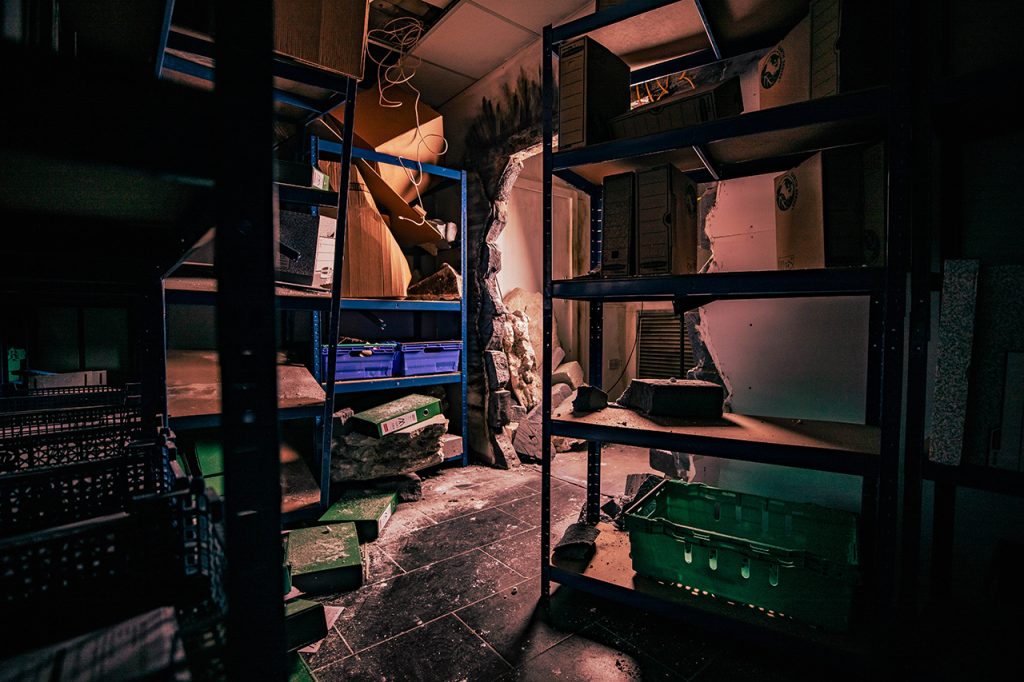
What could be improved?
- An ending cut short? The ending was both brilliant but, for me at least, deeply unsatisfying. I’d been warmed up, my heart was beat-beat-beating. I don’t like scary films and scary rides but this was so thrilling. I was completely engaged in the story, hungry for more. But then, all of a sudden, like a door slammed in your face, it was all over. We were told we had to leave the room, and that was that. Having gone into the hotel and had that deeply strange experience of entering a room alive with fear, with no idea what to expect – I felt like there might be another step, one last hurrah, perhaps a denouement. There’s a lot to be said for climaxes, for big bang endings. And although the peak-end rule suggests endings are key, new research is strongly challenging this idea – see the fascinating research that Wim Strijbosch shared at Campfire 25. But besides this, great endings don’t just end on the high-end bang, you don’t just stop once you’ve reached the peak — they have to bring you down from the mountain.
- I think the beginning could be better too. The set was superb. It felt like an office, there were hints of the Isklander trilogy, so this was ideal for whatever level of engaged fan you might be – skimmer, swimmer, or diver in Martin Coat’s terminology. But at the desk we were greeted with service rather than experience. It was functional: what’s your name, fill in your name, sign a waiver. But why not make this part of the story? Why spend money, time and attention on the set, but then not set up the staff to be part of the experience too? Crossing the threshold from the real world into the experience is so much better when it’s done in stages, in the sort of incremental step-by-steps that Annette Mees talked about at Campfire 12 and worked so well in the Royal Opera House’s Current Rising.
- I wonder if I could have had a copy of that footage? That may spoil it for others who might go. Perhaps there’s a date – six months after they close it? – where they could release these.
Which elements do you like so much you’d like to use them in your work?
- The intermixing of the world of the adventure and the real world was both very surprising and literally thrilling. It makes me wonder how you can take the norms of a genre, and look at what’s not done, and then do that.
- The mix of pre-recorded footage and real footage was a great way to tell a story. Watching TV news and suddenly seeing yourself and your friends there… surreal and very good fun.
- The surprising use of another location was really fun. The sense of wonder and more powerful memory it created was quite something (I can picture the team and I wandering the streets of London, laughing, talking, on edge, having fun like kids). It makes me wonder how I could move people in an event.
- Entering a hotel, slipping past the staff, and heading up to a room as if we were on a secret mission was also great fun. And it’s set an exceptional memory trigger: I’m sure next time I’m travelling for work and walking down the corridor to my room in a hotel, that moment will come back to me. So it makes me wonder, what memory triggers for the future can I set during an experience?
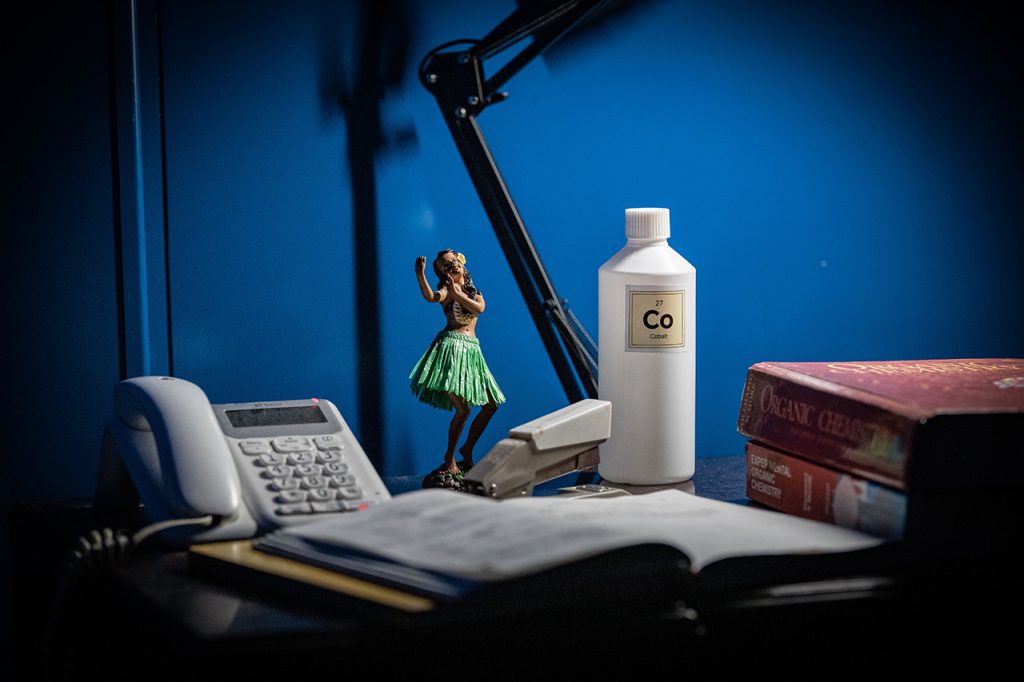
Mark Slade: “Lying to the audience is brave but when you feel you have been lied to for your own good, strategic deceit pays off!”
What’s good about the experience?
- I loved the plot twists.The narrative behind the experience literally hijacks itself, leaving you momentarily stunned and suddenly questioning your preconceived idea of what The Drop is. The story design in the first half of the experience is really clever because it flips the whole marketing creative and initial part of the experience on its head. It would be criminal to say how they do this because it would literally ruin the experience by spilling all of the beans here. So I’ll just spill a few.
- The way in which the plot twist revealed unexpected physical stages of the experience was great, too. To begin with, your assumption is that unless you can solve a sequence of challenges before the time runs out then the elevator you are inside will drop you to your (simulated?!) death. Looking back, it’s really funny to think that we were all blatantly grabbing for the handrails around the elevator in response to that predetermined fear state.
- The transformation of the story plot and the script and acting that brings it to life is gripping. I loved that the tone and language changed from in-world to seemingly real-world. One minute I was stunned to think that the operators would drop the ball even if something technical had gone wrong. The next minute I was thinking how genius it was that the script and design of the story had made me think that, even if just for a moment.
- The Drop keeps the audience firmly on their toes and guessing all the way through. The tension ratchets upwards through to the final scene. Moving us into unexpected spaces that are initially teased out on small CCTV screens inside the elevator was a compelling way to create a genuine sense of connected immersion through the story.
- Taking the experience from such a confined space and onto street level is genius. You are consumed with a feeling of excitement and pending danger but it also gives you a sense of independence within the story as if you and your friends are now driving the next chapter. We did have a chuckle at the thought of some groups taking a wrong turn under the influence of a few pre-show courage drinks and wandering off into the night rigid with tension.
- Using recognised BBC TV reportage and incorporating video of the audience to land the final part of the story was impactful and joined up the narrative to the physical set in a really smart way that gave you a sense of feeling like one of the cast or a star in your own movie. Again, I won’t reveal the details here but it’s a very cool deployment of audience generated content.
- One of the things that I enjoyed the most now that I have had time to absorb it was the finale, although my initial reaction was one of disappointment – but there lies the gold. Where you finish in The Drop feels as controversial as it is unexpected. The final act landed us in a place that reminded me fondly of The Game – where the safe boundaries of the experience are penetrated by perceived reality. It’s a brilliant piece of story design because you feel literally anything could happen next and you are about to experience that ultimate “what if”. I think each of us had their own version of what that next, final thing was going to be. The creators have expertly managed to provide the audience with fuel for a hugely debatable conversation over a (stiff) post show drink.
- It would be intriguing content to be able to watch the reactions from different groups debating what they think or thought would happen next. Again, with this particular experience I feel compelled not to reveal all here. Let’s just say that for about 3 hours after it finished we were still convinced that someone might be following us. In fact, at one point, Tracey (my new boss who bravely accepted an invitation to be locked up in an elevator with me after our first day in the office) yelped out in sheer panic at some poor random guy coming out of another elevator. It was unsettling, embarrassing yet completely understandable and of course completely hilarious, all at the same time!
What could be improved?
- The sound design was good and helped to create tension inside the elevator but the sound quality and volume was a little toppy and too quiet in key moments. Strategically placed, beefier bass speakers behind the walls would create a rumble and more impactful emotional response. You would imagine that in real life the sounds would be nerve jangling loud and more external coming from outside the confines of the elevator.
- There was a small crack of light permanently visible through the lower part of the elevator door. This sounds like a small detail but it jarred with the narrative progression and accompanying sound and visual effects. With the high frequency of shows taking place, I would assume this was wear and tear as the rest of the set design was slick but in the heat of the moment when the drama is cranking up, it’s easy for the magic to escape – even through a small crack in the door! An easy fix but it required a thorough check through of the set before we entered.
- The physical transitions through the narrative developments were smartly introduced, if initially a little predictable – but to be fair I guess there are only a limited number of authentically viable ways to escape from an elevator!
- The set design impact following the transition into the next space was a ‘wow’ moment but it could have been heightened further with the use of lingering smoke and smells caused by the explosion and collapsed wall that confronted us. Whilst these sensory elements would add to the cost and production complexity, they felt missing as opposed to nice-to-have because The Drop is an experience designed with a determined ambition to place you firmly into a non-fantastical, tangible alter-reality. Those sensory additions would help elevate that key reveal from an impressive theatrical set to an extremely convincing scene of a crime.
- The fine attention to detail and story craft presented through the various props is beautiful and nothing less than I expected from The Drop’s Creative Directors Ollie Jones and Clem Garrity (also creative associates of Punchdrunk and founders of Kill The Beast). However, because The Drop sets the audience up with an escape room race-against-the-clock mindset, I was unsure how much of this glorious detail was relevant – or ‘real’. I wanted more time to explore some of the set and wondered if we had missed pieces that would have made the story richer or even provided alternative twists at the end. I was also keen to see what would have happened if we had taken longer in our quest to advance through to the next stage and if we would have encountered ‘physical danger’ or other actor-based interactions. Ironically, in reality I think we probably had as much time as we liked, but we all felt compelled to move fast or risk ‘falling’. If there are hidden gems within the set props that require more exploration then the experience would benefit from giving the audience permission to explore a little more, rather than allowing our full, panicked focus being on escape alone.
- The set design inside the final room was great overall and the fact you find yourself in a real, working establishment is in itself hugely impressive – and massively unnerving. At one point, Tracey was literally rooted to spot at the thought we were going into an actual hotel room – that was the impact it had and so really any criticism of the set design inside feels harsh, but The Drop is a premium ticket that sets itself high expectations throughout. So, being a little harsh, I was slightly disappointed not to find some fresh blood splatter on the carpet, perhaps a police surveillance camera trained on the room when I opened the curtain and the sound of the shower on or someone moving around in the locked bathroom. Such builds, for me, would have put some set design icing on the experience finale cake. But there is also a valid argument here for less is more.
- Legalities, rules of engagement, practicalities and ethics aside, it was a shame (or for some people, probably welcome) that there was a formal, branded outro at the finale. I get why it’s needed but it would just have been so much cooler for me if the suspension was left hanging. Being asked to kindly pop the props back into the box killed that magic a bit.
- I would love to have received a real-world continuation after the experience. Whilst a knock at my (physical) door was of course never going to be practical for an experience marketed at scale, I imagined how terrifyingly cool it would be if I had received a call or text message later that night with an extra piece of information.
- Finally, I was hoping that there might be an opportunity to buy some in-world merch. Not branded gift shop fodder but a piece of story extension, limited-edition goodness. This is an area that I am really excited about within experience design, but I am yet to see anyone doing it in a hugely compelling way that adds weight to the narrative. For example, at one point in The Drop we were in a high-end perfume shop. How cool would it be to receive an ad the following day promoting a perfume or aftershave from that very shop – even if this was done in collaboration with a real brand, it would extend the experience, create a shareable asset for the audience and generate an additional revenue stream. As a sucker for good merch, I would have made such a purchase for sure.
Which elements did you like so much you’d like to use them in your work?
- The false narrative setup was great. I love the idea of using the marketing to create a sense of excitement and story teaser and then taking the audience somewhere completely different. Lying to the audience is brave but when you feel you have been lied to for your own good, strategic deceit pays off!
- The Drop uses multiple platforms to craft the narrative and make the audience work, which creates a sense of realism way beyond any other escape room-type experience I have been to. Embracing the use of mobile phones and providing an in-world WiFi password at the outset enhanced this further.
- It sounds small and boring, but it was great that there was no cloakroom. Having to work around your coat and pull your stuff awkwardly through the experience with you made it feel real. It’s amazing how having to remember your bag can add so much to the tension of a high drama moment.
- The opportunity that the story presented for landing the audience in a ‘real’ alternative reality via the red herring of an ‘escape room’ was ballsy and exciting. Smashing different experience frameworks together in this way and ignoring a few ‘rules’ feels fresh and innovative.
- Swearing! Lots of swearing – from the production staff (who were not actually the production staff, or were they?), just like you would if you had a gun to your head. The realistic, gritty script in the first half of the experience really helped sell the plot twist and reminded me that the most impactful way to convince an audience that something is ‘real’ is to deliver it with authenticity and intent.
Olivia Squire: “The psychological aspect was probably the most challenging thing – I had nightmares afterwards!”
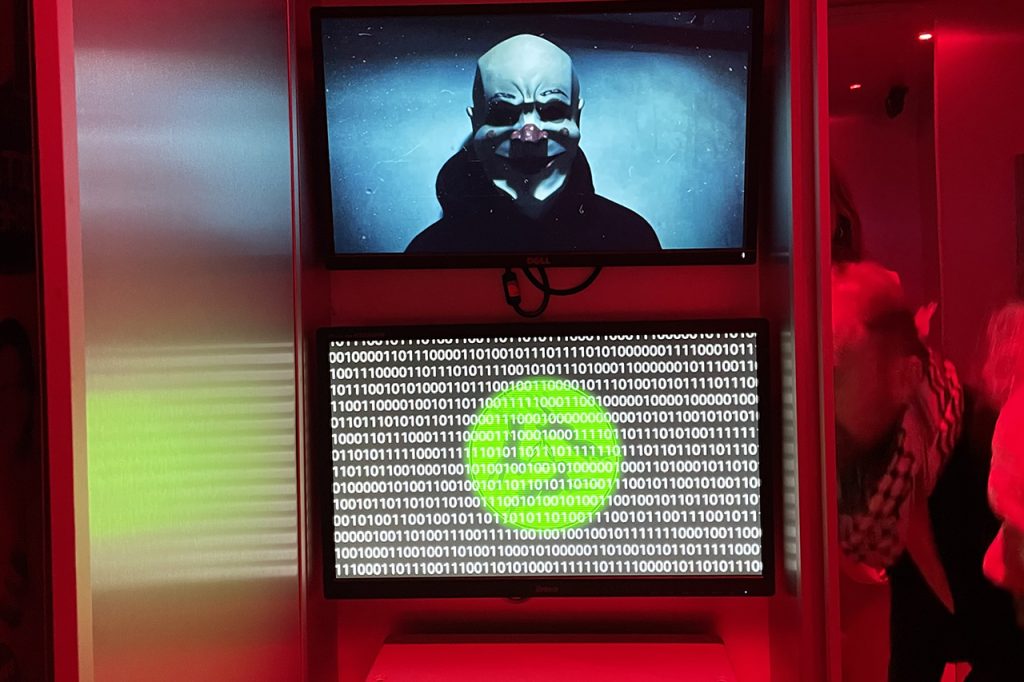
What’s good about the experience?
- The initial double-bluff was so well done that it was genuinely unsettling and put us in a state of vulnerability (and hyper alertness!) straight away. As quite experienced, er, experience consumers, making us feel like we didn’t know what was coming next was quite a feat – and the surprise and delight kept coming throughout, from the progression through locations to plot twists.
- In Campfire 30, Maël Magat talked about fear, pressure and progression being three of the tools he uses to get people “in flow”, and The Drop definitely reminded me of these. Without giving it away, there’s a certain moment that definitely flips the switch from complacency/having a laugh to terror/getting out of the situation and from that point on we were definitely in flow. I didn’t look at my phone once (except when I was directed to use it at certain points in the experience).
- On this note, having elements that linked to the wider world – websites, texts, phone numbers – made the story feel more authentic and like it might live on after the experience. I found myself revisiting some of the links on my bus ride home as I wanted to see if there were any clues I’d missed in the heat of the moment.
- The puzzles were just the right amount of challenging – satisfying to get right, but not so hard we couldn’t manage them. We were also given nudges when needed. We got stuck on one quite easy thing, but this definitely felt like our fault rather than a design flaw, and overall there was a satisfying sense of collectively overcoming obstacles. The psychological aspect was probably the most challenging thing – I had nightmares afterwards!
- It was great at bonding us as a team. I think being in a small group and largely within a small space contributed to this. We were “transformed” from a group of semi-strangers to a team, even if we weren’t transformed individually… if anything, I think perhaps it amplified who we already were!
- The small numbers made it feel much more autonomous and exciting than something like Secret Cinema or Punchdrunk because we were the centre of the experience rather than semi-active observers.
- The set design, particularly in the first half of the experience, also felt more realistic than previous immersive theatre or escape rooms I’d been to, which made me feel like I was actually in a world rather than walking through a set.
- I thought the background audio – laughs, screams – was really effective, even when it wasn’t the centre of what was going on in that moment.
What could be improved?
- Make it clearer that there’s an element of autonomy. I approached it as a classic escape room where you’re carried through a set narrative, and wouldn’t have realised that there was any scope to change that if the producers hadn’t told us afterwards – I might also have made different decisions throughout and felt a bit more invested. Knowing this also makes me want to repeat the experience to see how my actions might affect the outcome – something I didn’t necessarily feel upon finishing initially.
- Start world-building earlier or even before arriving, for example like Secret Cinema does by giving you a character, dress code, backstory etc. I wasn’t really aware of why I’d been invited to this office for a meeting, so I hadn’t thought about my “character” or felt much anticipation beyond being intrigued about what was about to happen. The FAQ was also pretty dry and meant that one of our party hadn’t properly read it, and was therefore unable to take part because of her claustrophobia… better/more exciting prep would help make sure people are primed for the right level of discomfort, i.e. challenging rather than terrifying!
- Similarly, I recommended it to lots of my friends, but it’s not for everyone – I felt like I had to give away a few parts of the experience to make sure I wasn’t setting someone up for a bad time. Perhaps they could lean into this in the marketing so people have “good nerves” rather than “bad nerves”.
- The set upon arrival was SO convincing that I didn’t even realise it was a set and thought it was just a rented office space. On the one hand, this definitely made the experience feel authentic; on the other, amplifying some of the uncanny elements to make it clear that you’ve “crossed the threshold” could have helped you get into character. Other than being told by the arrival staff that “things get pretty weird as soon as you step inside”, nothing felt particularly off or exciting. Although you could argue that when things did start to go (purposefully) awry in the lift, the impact was even greater for the mundane beginning.
- The first half-hour or so in the lift was definitely the strongest; I felt like once we stepped through into the second part of the experience, it felt much more like a “set” or a classic escape room setting, which broke the illusion and the foreboding atmosphere a little. Once we were back on the street and in the final location, it flipped back into feeling more realistic and unpredictable.
- Could they provide a “memory anchor” or some leads to follow up after the event, for example a link to watch the BBC news report again that could link to other websites? I didn’t necessarily feel like I’d understood the whole story and might have liked to research it more afterwards. Some of our party were also so over excited that they missed the twist at the end – a way of revisiting it and tying all the threads together might have made it more memorable beyond the shock of the plot twist. The atmosphere was so exciting I almost didn’t care about the story, but if it had been clearer at the beginning and end, I might have been more invested in extending it by research or repeating the experience.
- As we were at a preview, we ended in the bar and were able to discuss the experience with other people who’d been through it – however I’d like to know how “regular” audiences are discharged. Are you just ejected from the hotel room onto the street and that’s it? It almost felt like a shock when it ended, as we were all in hyper sleuth-mode – I wonder if there’s a better way you could slowly introduce people back to reality?
- Perhaps there could have been more sensory elements introduced, namely scent could have worked really well – the perfume shop! Smoke from the explosion! I don’t remember there being anything like this, which feels like maybe a missed opportunity.
Which elements do you like so much you’d like to use them in your work?
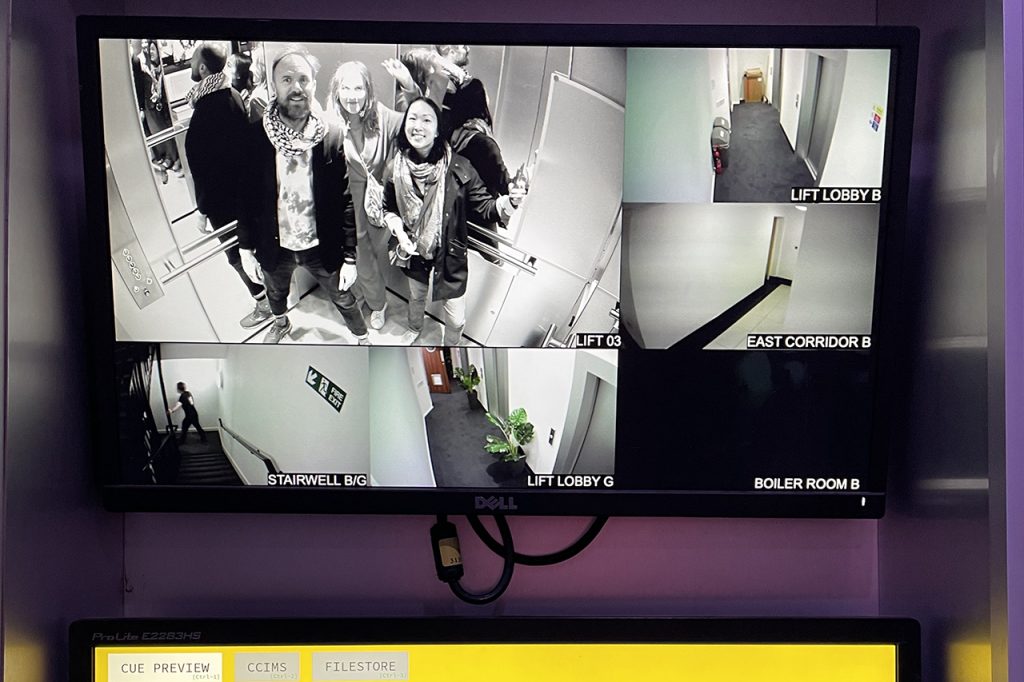
- I liked the way they built a participatory world of content using fairly simple technology – extraneous websites, phone numbers, texts, etc – and wonder if there’s a way we could apply this when writing for the web. Reading articles can be a passive experiences, and most of the more engaging or impressive interactive digital articles I’ve read have clearly involved a lot of expensive design. Maybe there’s something here in how to make them feel dynamic without the £££…
- Similarly, it’d be interesting to see how we could make people work for the answers to a question rather than just providing them. Maybe it’s about asking the right questions rather than having all the answers!
If you’re in London and would like to try The Drop for yourself, you can book tickets here.
Read more WXO Experience Reviews here – if you would like us to review your experience, get in touch.

